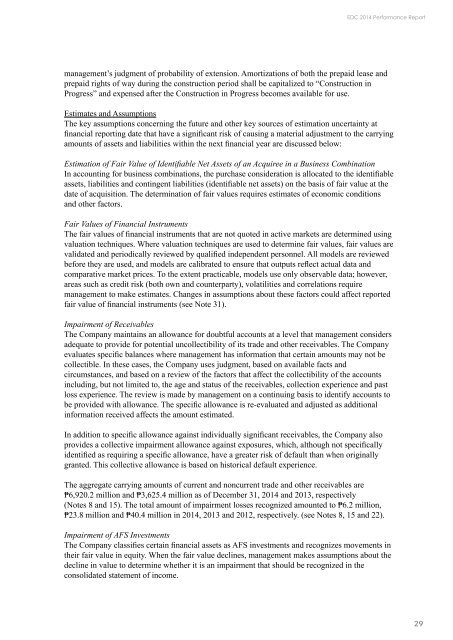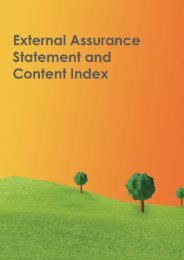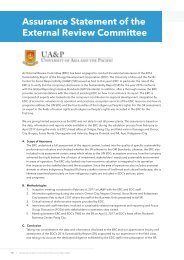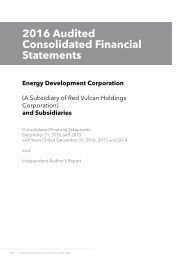2014 Financial Statement
Create successful ePaper yourself
Turn your PDF publications into a flip-book with our unique Google optimized e-Paper software.
EDC <strong>2014</strong> Performance Report<br />
management’s judgment of probability of extension. Amortizations of both the prepaid lease and<br />
prepaid rights of way during the construction period shall be capitalized to “Construction in<br />
Progress” and expensed after the Construction in Progress becomes available for use.<br />
Estimates and Assumptions<br />
The key assumptions concerning the future and other key sources of estimation uncertainty at<br />
financial reporting date that have a significant risk of causing a material adjustment to the carrying<br />
amounts of assets and liabilities within the next financial year are discussed below:<br />
Estimation of Fair Value of Identifiable Net Assets of an Acquiree in a Business Combination<br />
In accounting for business combinations, the purchase consideration is allocated to the identifiable<br />
assets, liabilities and contingent liabilities (identifiable net assets) on the basis of fair value at the<br />
date of acquisition. The determination of fair values requires estimates of economic conditions<br />
and other factors.<br />
Fair Values of <strong>Financial</strong> Instruments<br />
The fair values of financial instruments that are not quoted in active markets are determined using<br />
valuation techniques. Where valuation techniques are used to determine fair values, fair values are<br />
validated and periodically reviewed by qualified independent personnel. All models are reviewed<br />
before they are used, and models are calibrated to ensure that outputs reflect actual data and<br />
comparative market prices. To the extent practicable, models use only observable data; however,<br />
areas such as credit risk (both own and counterparty), volatilities and correlations require<br />
management to make estimates. Changes in assumptions about these factors could affect reported<br />
fair value of financial instruments (see Note 31).<br />
Impairment of Receivables<br />
The Company maintains an allowance for doubtful accounts at a level that management considers<br />
adequate to provide for potential uncollectibility of its trade and other receivables. The Company<br />
evaluates specific balances where management has information that certain amounts may not be<br />
collectible. In these cases, the Company uses judgment, based on available facts and<br />
circumstances, and based on a review of the factors that affect the collectibility of the accounts<br />
including, but not limited to, the age and status of the receivables, collection experience and past<br />
loss experience. The review is made by management on a continuing basis to identify accounts to<br />
be provided with allowance. The specific allowance is re-evaluated and adjusted as additional<br />
information received affects the amount estimated.<br />
In addition to specific allowance against individually significant receivables, the Company also<br />
provides a collective impairment allowance against exposures, which, although not specifically<br />
identified as requiring a specific allowance, have a greater risk of default than when originally<br />
granted. This collective allowance is based on historical default experience.<br />
The aggregate carrying amounts of current and noncurrent trade and other receivables are<br />
₱6,920.2 million and ₱3,625.4 million as of December 31, <strong>2014</strong> and 2013, respectively<br />
(Notes 8 and 15). The total amount of impairment losses recognized amounted to ₱6.2 million,<br />
₱23.8 million and ₱40.4 million in <strong>2014</strong>, 2013 and 2012, respectively. (see Notes 8, 15 and 22).<br />
Impairment of AFS Investments<br />
The Company classifies certain financial assets as AFS investments and recognizes movements in<br />
their fair value in equity. When the fair value declines, management makes assumptions about the<br />
decline in value to determine whether it is an impairment that should be recognized in the<br />
consolidated statement of income.<br />
29
















